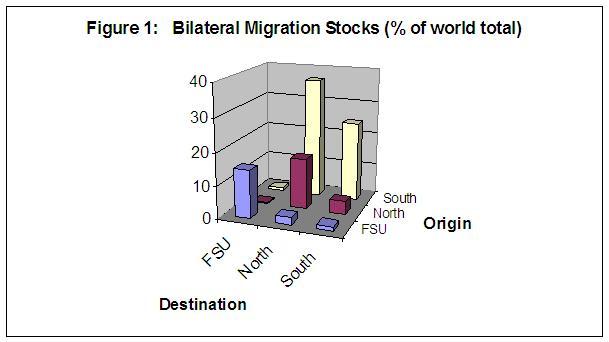Every day in America or Europe there is a story about migration policy, and every other day there is a story about how little information we have on the number of migrants. In fact, for rich countries we generally know roughly how many there were at the turn of the century, but for most countries, especially the smaller ones, we hardly know at all. Recently, researchers at the University of Sussex and the World Bank have created a database that helps to address this issue, by quantifying how many people from each country resided in each other country around the year 2000.1 This is interesting in itself – how many Americans are there in Paris? – and allows us to test some simple hypotheses. Even more importantly, it provides a factual base on which researchers and policy-makers can start to address questions about global migration and policy. Perhaps surprisingly, it is the first such database at a global level.
Patterns of Migration
Around 2000, there were approximately 176 million international migrants – people living in a country other than that in which they were born. Twelve countries account for half of world immigration, starting with the USA, which is home to nearly 35 million international migrants, and Germany has 9 million. The leading source countries are Mexico (10 million) and India (9 million). The United Kingdom, Germany, India and Pakistan are all among both the top eight destinations and sources.
Table 1 Top five destination and origin countries
| Countries of immigration |
Countries of emigration |
| United States |
Mexico |
| Germany |
India |
| France |
Bangladesh |
| India |
China |
| Canada |
Uk |
Note: excluding FSU – see footnote 2 below.
In 2000, around 12.5% of the United States’ population was foreign-born. Australia, Canada and Saudi Arabia show higher percentages and Western Europe not much smaller. Among sources, large absolute migrations generally come to/from large countries, but they are typically smaller proportionately than for small countries. Several small countries have more people abroad than at home or more immigrants than locals among the resident population.
Where do all these people go to or come from? Figure 1 summarises the regional data, distinguishing North (rich), South (poor) and the FSU countries. The bulk of FSU migration is intra-regional and probably largely spurious.2 For Northern emigrants, the principal destination is other Northern countries. Southern emigrants, on the other hand, go more to Northern destinations than to Southern ones and outnumber Northern migrants in those countries. But as recipients, Southern countries get most of their immigrants from other poor countries. Overall, South-to-North emigration accounts for 37% of total emigration, South-South for 24% and North-North for 16%.
The largest (non-spurious) regional share is the stock of Latin Americans (including Mexicans) in the USA (10% of the world total), followed by intra-Sub-Saharan Africa (7%) and intra-South Asian (6%) migration. High intra-Sub-Saharan Africa migration probably reflects the facts that (a) much of African migration is forced (refugee flows) and by poor people, so proximity is crucial; and (b) Africans generally find great difficulty entering other countries.
Even with a more detailed regional breakdown, much migration remains intra-regional. There are strong differences in patterns between regions. Thus we see Europeans accounting for significant shares of immigration into Europe, Canada and Australia, but nowhere else. For the USA, the dominant origin is Latin America, accounting for 52% of the total, and that region is also important in Japan’s (admittedly small) total. The latter reflects the special treatment offered to Latin Americans of Japanese ethnic origin. Even more striking is the share of immigrants from East Asia and the Pacific in Japan’s total immigrant stock, although in absolute numbers Australia and New Zealand are more important destinations for Asian/Pacific residents. Among high-income regions, only the Gulf has a high share of South Asians and, as already hinted, nowhere at all has a high share of Africans.
The choice of destinations also varies across regions. For Northern regions, the principal destinations are Northern, fully 80% for Europe. For developing country origins, the principal destinations are intra-regional, especially for Eastern Europe and Central Asia (ECA) and Sub-Saharan Africa. But beyond that, we see different degrees of reliance on the Gulf (high for South Asia and the Middle East/North Africa - MENA), Europe (high for ECA and MENA) and North American (high for Latin America and East Asia). It is not difficult to see the role of geography in the creation of these corridors, but equally well one can see that geography is not all.
At a country level, some countries rely heavily on neighbours, but this is not universally so. For example, in India and Iran, over 90% of immigration is from neighbouring countries, whereas Pakistan appears to receive most of its immigrants from Bangladesh and has only 17% from contiguous countries. The flow from Mexico to the USA accounts for about 93% of Mexican emigration, but only 30% of US immigration. Fully 51% of migration takes place within these language blocks – most strongly the English one. This is as true of South-South flows as of North-South or North-North.
A second influence on migration is distance. The mean distance between home and host for all migrants in the world is a formidable 4,225 kilometres, but within that there are clear negative correlations between distance and the number migrants.
A third influence is income. This, of course, is an individual or household matter, dependent on the individual’s circumstances before and after migration and so country data are only very crude indications. However, attributing to every migration an income difference equal to the difference in average gross national income (GNI) per capita in 2001 between the source and destination countries, the mean gain in income is $9,479.3 Similarly, for every intra-regional flow, the mean is positive.
Where do these data come from?
Describing patterns is easy once you have the data, but where do these come from and how reliable are they? We believe that these data are as good as migration data get, but they are far from perfect.4 They refer to the stock of migrants by destination and origin and are derived mainly from national population censuses from around the year 2000.
Censuses differ greatly and a great deal of effort went into making them as comparable as possible – see the original source. The Sussex database comprises four versions of two origin-destination matrices for 226 countries and territories. The first matrix records foreign population defined by country of birth and the second by nationality or citizenship. The four versions reflect different points on the trade-off between the comprehensiveness of coverage and the use of assumption and interpolation to compensate for missing data. The first simply contains the raw data with some minor adjustments. It covers about 164 million observations. The second version seeks to break up unallocated categories, and the third to convert to different definitions data that rely on ethnic definitions of foreigners.
Version 4 of the data, which we use in this article, is the fullest but least accurate set. It supplements the foreign-born matrix with shares across sending countries derived from the nationality matrix, augments the foreign-born matrix with the United Nations (2004) totals for 2000 where no other data were available, and reconciles all of the remainder categories. Finally, it scales all the data predating 2000 to the United Nations (2004) total for that year. The decision to produce the final matrix utilising the foreign-born definition was based on the fact that more countries report data by place of birth, that this definition is less vulnerable to differences in naturalisation policies across countries and that it more readily accords to the actual movement of migrants, which is the economist’s principal interest.
So, how many Americans are there in Paris? We can’t say because we don’t have city data, but in 2000 there were slightly over 204,000 Americans in France.
Footnotes
1 This note is based on ‘Quantifying International Migration: A Database of Bilateral Migrant Stocks’, by Christopher R. Parsons, Ronald Skeldon, Terrie L. Walmsley, and L. Alan Winters, Chapter 1 of C Ozden and M Schiff (ed.s) International Migration, Economic Develoment and Policy, Palgrave and The World Bank, 2007, pp. 17-58. A summary is available in CEPR Policy Insight 17. The research was initiated and supported by the Development Research Centre on Migration, Globalisation and Poverty at the University of Sussex that is supported by the Department for International Development, United Kingdom.The data are available online.
2 As a single country, the USSR had considerable internal mobility (some forced), so when it split up, many of the people found themselves living in a country other than their birth; i.e. many of their ‘migrants’ have never moved – rather their countries moved!
3 These figures far exceed the likely gain for any family: factors other than labour receive some of the GNP pc and in most cases migrants start with relatively higher incomes in their home countries and at least for several years do relatively less well in their new locations.
4 This is a brief summary. The original source describes the data and their derivation in excruciating detail.



